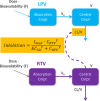Pharmacokinetics and Drug-Drug Interactions of Lopinavir-Ritonavir Administered with First- and Second-Line Antituberculosis Drugs in HIV-Infected Children Treated for Multidrug-Resistant Tuberculosis
- PMID: 29133558
- PMCID: PMC5786799
- DOI: 10.1128/AAC.00420-17
Pharmacokinetics and Drug-Drug Interactions of Lopinavir-Ritonavir Administered with First- and Second-Line Antituberculosis Drugs in HIV-Infected Children Treated for Multidrug-Resistant Tuberculosis
Abstract
Lopinavir-ritonavir forms the backbone of current first-line antiretroviral regimens in young HIV-infected children. As multidrug-resistant (MDR) tuberculosis (TB) frequently occurs in young children in high-burden TB settings, it is important to identify potential interactions between MDR-TB treatment and lopinavir-ritonavir. We describe the pharmacokinetics of and potential drug-drug interactions between lopinavir-ritonavir and drugs routinely used for MDR-TB treatment in HIV-infected children. A combined population pharmacokinetic model was developed to jointly describe the pharmacokinetics of lopinavir and ritonavir in 32 HIV-infected children (16 with MDR-TB receiving treatment with combinations of high-dose isoniazid, pyrazinamide, ethambutol, ethionamide, terizidone, a fluoroquinolone, and amikacin and 16 without TB) who were established on a lopinavir-ritonavir-containing antiretroviral regimen. One-compartment models with first-order absorption and elimination for both lopinavir and ritonavir were combined into an integrated model. The dynamic inhibitory effect of the ritonavir concentration on lopinavir clearance was described using a maximum inhibition model. Even after adjustment for the effect of body weight with allometric scaling, a large variability in lopinavir and ritonavir exposure, together with strong correlations between the pharmacokinetic parameters of lopinavir and ritonavir, was detected. MDR-TB treatment did not have a significant effect on the bioavailability, clearance, or absorption rate constants of lopinavir or ritonavir. Most children (81% of children with MDR-TB, 88% of controls) achieved therapeutic lopinavir trough concentrations (>1 mg/liter). The coadministration of lopinavir-ritonavir with drugs routinely used for the treatment of MDR-TB was found to have no significant effect on the key pharmacokinetic parameters of lopinavir or ritonavir. These findings should be considered in the context of the large interpatient variability found in the present study and the study's modest sample size.
Keywords: Mycobacterium tuberculosis; antiretroviral agents; drug interactions; human immunodeficiency virus; multidrug resistance; pediatric drug therapy; pediatric infectious disease; pharmacokinetics; population pharmacokinetics.
Copyright © 2018 American Society for Microbiology.
Figures




Similar articles
-
Population pharmacokinetics of lopinavir and ritonavir in combination with rifampicin-based antitubercular treatment in HIV-infected children.Antivir Ther. 2012;17(1):25-33. doi: 10.3851/IMP1915. Antivir Ther. 2012. PMID: 22267466 Free PMC article.
-
Abacavir Exposure in Children Cotreated for Tuberculosis with Rifampin and Superboosted Lopinavir-Ritonavir.Antimicrob Agents Chemother. 2020 Apr 21;64(5):e01923-19. doi: 10.1128/AAC.01923-19. Print 2020 Apr 21. Antimicrob Agents Chemother. 2020. PMID: 32071055 Free PMC article.
-
Confirming model-predicted pharmacokinetic interactions between bedaquiline and lopinavir/ritonavir or nevirapine in patients with HIV and drug-resistant tuberculosis.Int J Antimicrob Agents. 2017 Feb;49(2):212-217. doi: 10.1016/j.ijantimicag.2016.10.020. Epub 2016 Dec 14. Int J Antimicrob Agents. 2017. PMID: 28038962
-
Treatment and outcomes in children with multidrug-resistant tuberculosis: A systematic review and individual patient data meta-analysis.PLoS Med. 2018 Jul 11;15(7):e1002591. doi: 10.1371/journal.pmed.1002591. eCollection 2018 Jul. PLoS Med. 2018. PMID: 29995958 Free PMC article.
-
Optimizing treatment outcome of first-line anti-tuberculosis drugs: the role of therapeutic drug monitoring.Eur J Clin Pharmacol. 2016 Aug;72(8):905-16. doi: 10.1007/s00228-016-2083-4. Epub 2016 Jun 15. Eur J Clin Pharmacol. 2016. PMID: 27305904 Review.
Cited by
-
Advances and challenges in the prevention and treatment of COVID-19.Int J Med Sci. 2020 Jul 9;17(12):1803-1810. doi: 10.7150/ijms.47836. eCollection 2020. Int J Med Sci. 2020. PMID: 32714083 Free PMC article. Review.
-
Recent progress in understanding 2019 novel coronavirus (SARS-CoV-2) associated with human respiratory disease: detection, mechanisms and treatment.Int J Antimicrob Agents. 2020 May;55(5):105950. doi: 10.1016/j.ijantimicag.2020.105950. Epub 2020 Mar 29. Int J Antimicrob Agents. 2020. PMID: 32234465 Free PMC article.
-
MDR Tuberculosis Treatment.Medicina (Kaunas). 2022 Jan 26;58(2):188. doi: 10.3390/medicina58020188. Medicina (Kaunas). 2022. PMID: 35208510 Free PMC article. Review.
-
Clinical Relevance of Drug Interactions in People Living with Human Immunodeficiency Virus on Antiretroviral Therapy-Update 2022: Systematic Review.Pharmaceutics. 2023 Oct 18;15(10):2488. doi: 10.3390/pharmaceutics15102488. Pharmaceutics. 2023. PMID: 37896248 Free PMC article. Review.
-
Palestinian strategies, guidelines, and challenges in the treatment and management of coronavirus disease-2019 (COVID-19).Avicenna J Med. 2020 Oct 13;10(4):135-162. doi: 10.4103/ajm.ajm_171_20. eCollection 2020 Oct-Dec. Avicenna J Med. 2020. PMID: 33437687 Free PMC article. Review.
References
-
- World Health Organization. 2013. Treatment of children living with HIV. World Health Organization, Geneva, Switzerland: http://www.who.int/hiv/topics/paediatric/en/.
-
- World Health Organization. 2015. Tuberculosis. World Health Organization, Geneva, Switzerland. http://www.who.int/mediacentre/factsheets/fs104/en/.
Publication types
MeSH terms
Substances
Grants and funding
LinkOut - more resources
Full Text Sources
Other Literature Sources
Medical
Research Materials

